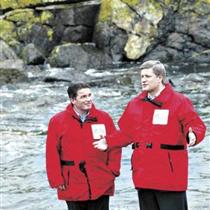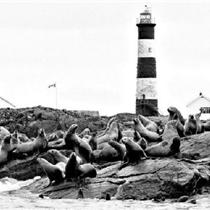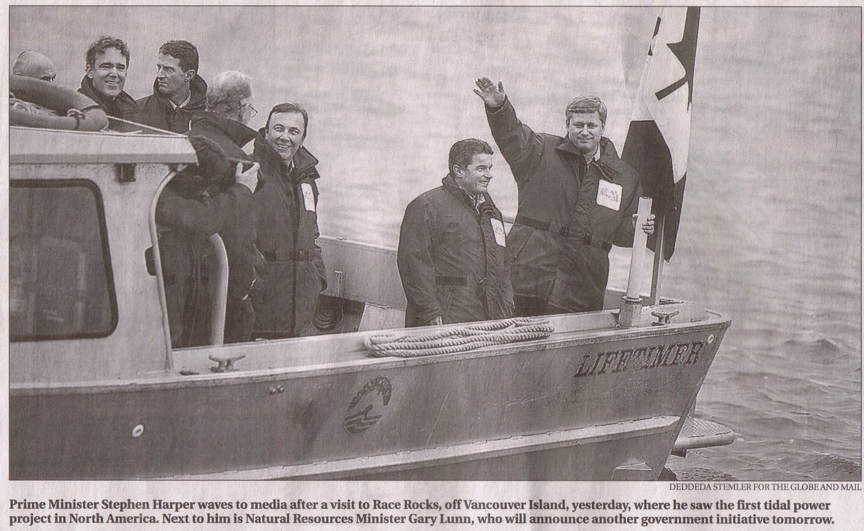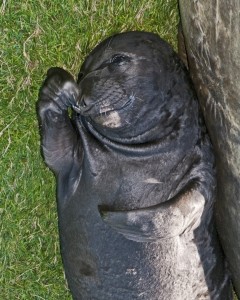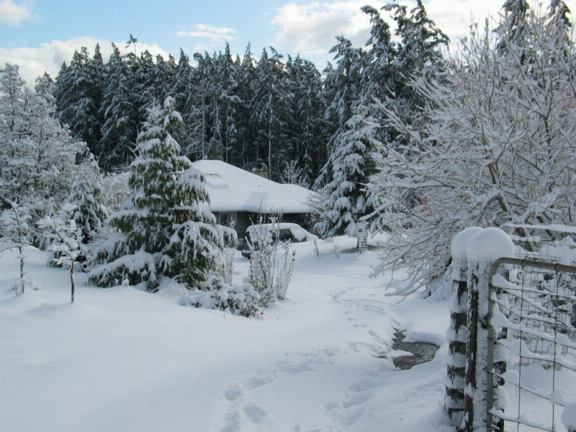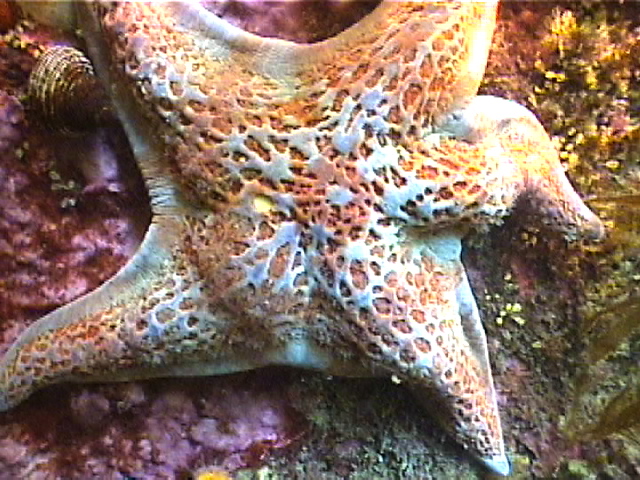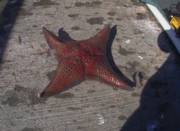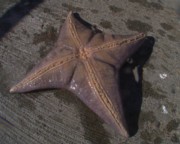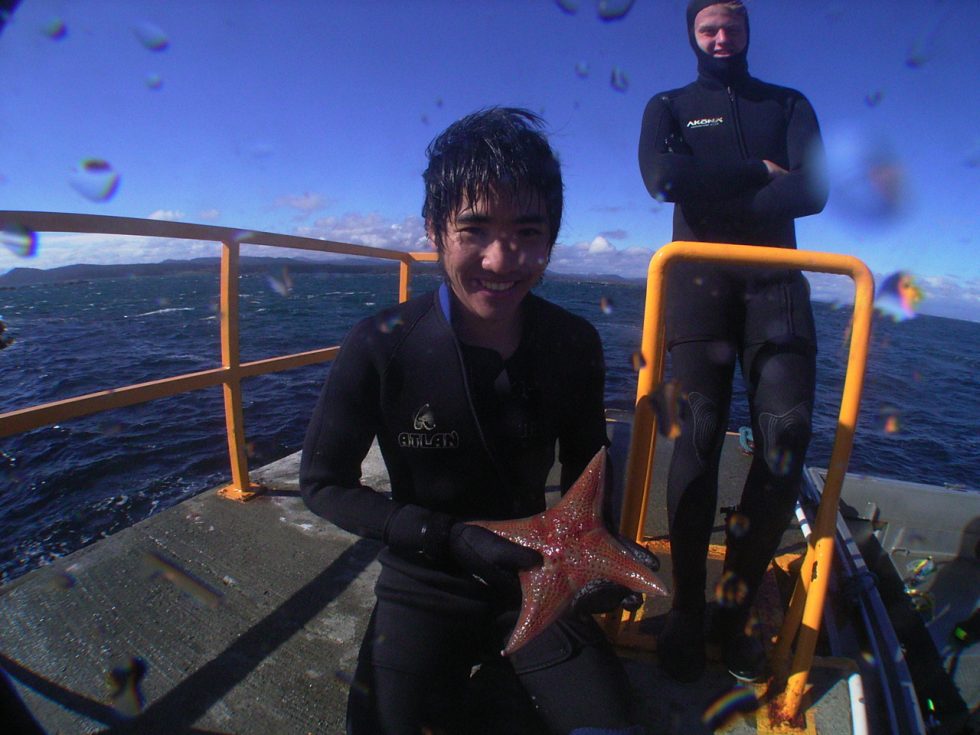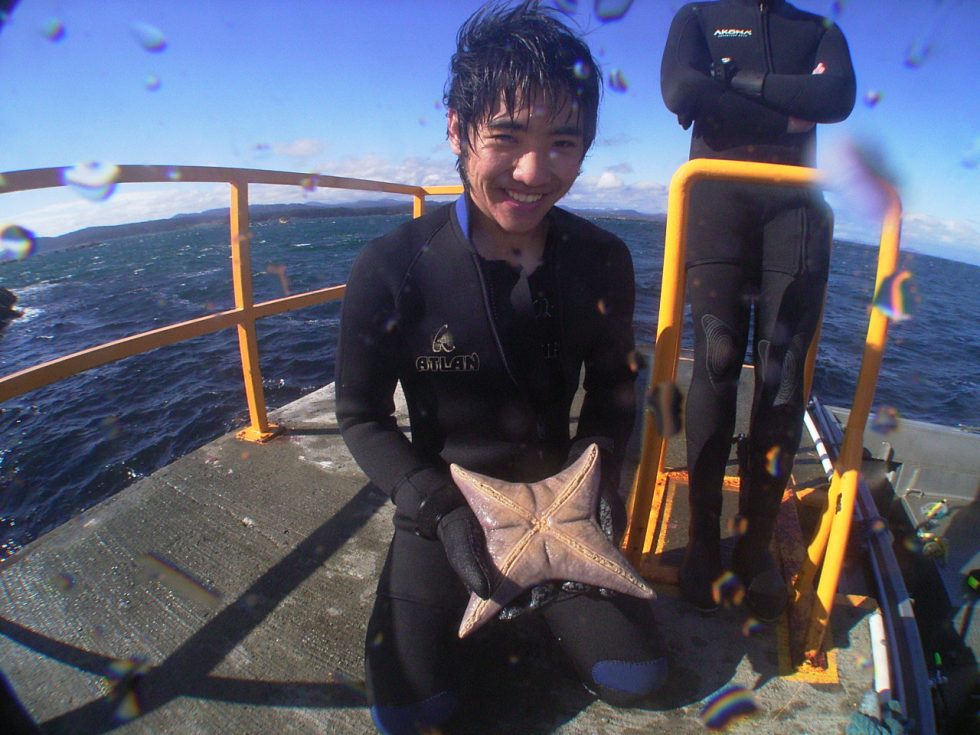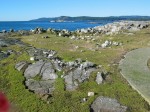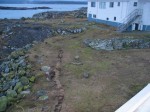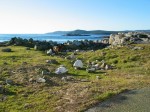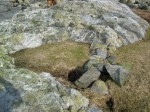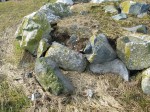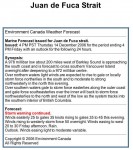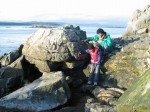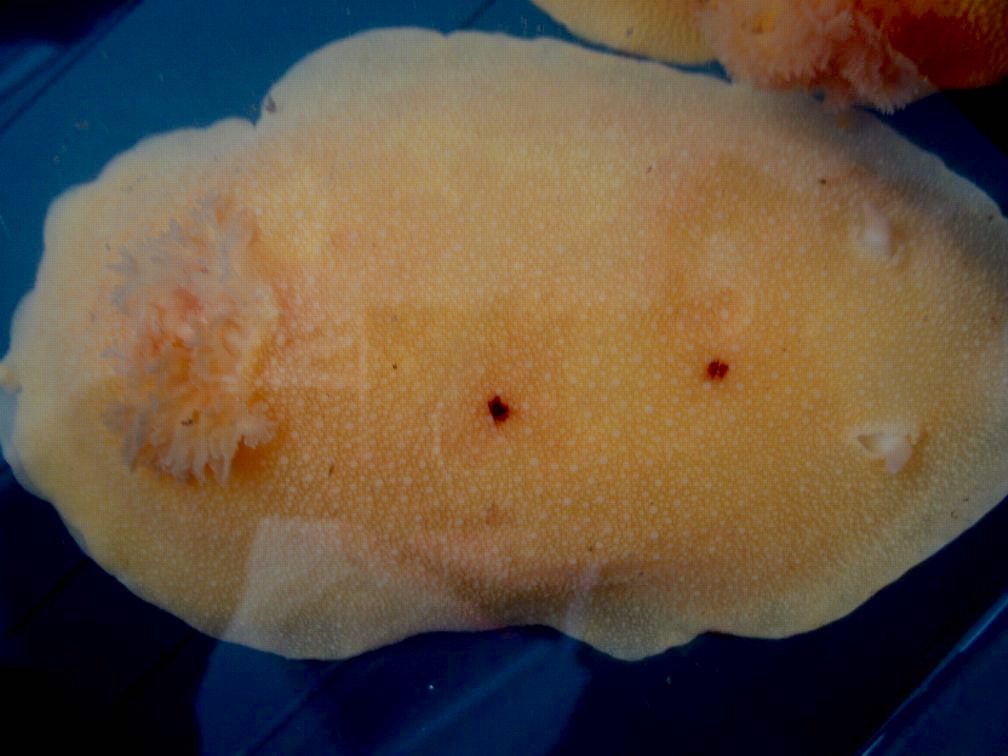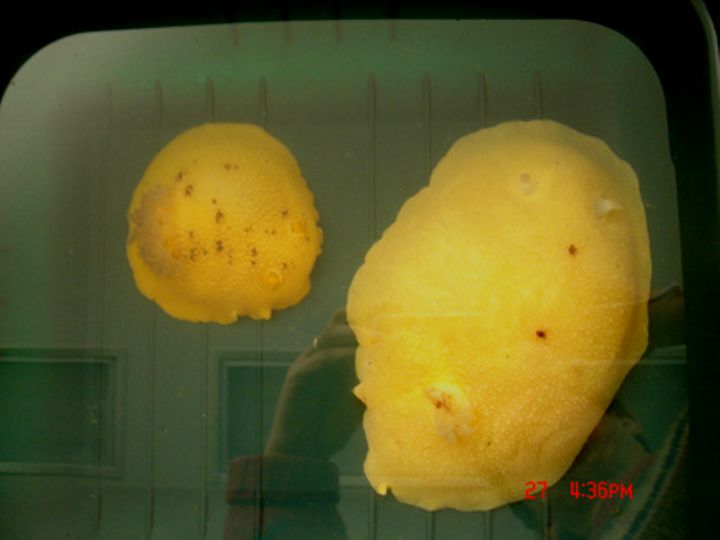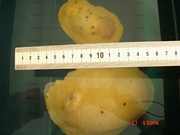 On January 19 2007,Prime Minister Stephen Harper and two federal cabinet ministers, Gary Lunn and John Baird pose with Glenn Darou beside a scale model of the energy generating turbine installed at Race Rocks in September of 2006.
On January 19 2007,Prime Minister Stephen Harper and two federal cabinet ministers, Gary Lunn and John Baird pose with Glenn Darou beside a scale model of the energy generating turbine installed at Race Rocks in September of 2006.
Further detail at this link:
https://www.racerocks.ca/prime-minister-stephen-harper-visits-pearson-college-and-race-rocks/
Prime Minister Stephen Harper Visits Pearson College and Race Rocks
 On January 19 2007,Prime Minister Stephen Harper and two federal cabinet ministers, Gary Lunn and John Baird pose with Glenn Darou beside a scale model of the energy generating turbine installed at Race Rocks in September of 2006.
On January 19 2007,Prime Minister Stephen Harper and two federal cabinet ministers, Gary Lunn and John Baird pose with Glenn Darou beside a scale model of the energy generating turbine installed at Race Rocks in September of 2006.
A number of other news media covered this event:
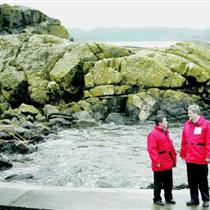 B.C. critical for Tory majority, Harper says Peter O’Neil, Vancouver Sun; Files from CanWest News Service Published: Saturday, January 20, 2007
B.C. critical for Tory majority, Harper says Peter O’Neil, Vancouver Sun; Files from CanWest News Service Published: Saturday, January 20, 2007
“OTTAWA — Prime Minister Stephen Harper, on Vancouver Island Friday to announce $1.5 billion for renewable energy initiatives, said B.C. is “critical” to his hopes of winning a majority government….” Harper was in Metchosin, near Victoria, to unveil an environmental incentive package in which the Conservatives will spend $1.5 billion over 10 years to boost Canada’s supply of wind, ocean, solar and other green energy. He said the package will boost the production of renewable energy by 4,000 megawatts a year. “In terms of greenhouse gas reductions, that’s the equivalent of taking one million cars off the road,” he said.
 Putting ‘green’ toward going green Edward Hill, Peninsula News Review Jan 24 2007 Putting ‘green’ toward going green Edward Hill, Peninsula News Review Jan 24 2007….”Prime Minister Stephen Harper announced a $1.5 billion funding package for clean green energy generation Friday at Lester B. Pearson College in Metchosin, the host of North America’s first operational tidal turbine. Coined the ecoEnergy Renewable Initiative, $1.48 billion over 10 years has been earmarked toward helping industry harness renewable, zero or low emission energy sources, such as wind, solar, tidal, wave, biomass or small hydro………” |
||
| PM to Boost Funding for Tidal Power… trip to Metchosin will heighten new Tory support for alternate energy Peter O’Neil, and Richard Watts, Times Colonist; CanWest News Service Published: Friday, January 19, 2007
|
| Tories announce $1.5-billion renewable energy plan, CBCnews “Harper said a 10-year incentive program, the so-called ecoEnergy Renewable Initiative, will be established to fund eligible projects to be constructed over the next four years.”
|
Tidal Energy ENCANA video
This video is a compressed version of the one produced by Brainstorm for the Tidal Current Power Project. It documents the partners and the process along the way in the establishment of the Turbine Project . (released January 19, 2007 to correspond with the visit of Prime Minister Stephen Harper to Lester Pearson College and Race Rocks. )
The Tidal Current Energy Project at Race Rocks
This video is a compressed version of the one produced by Brainstorm for the Tidal Current Power Project. It documents the partners and the process along the way in the establishment of the Turbine Project . (released January 19, 2007 to correspond with the visit of Prime Minister Stephen Harper to Lester Pearson College and Race Rocks.)
Stephen Harper visits Race Rocks
On January 19 2007,Prime Minister Stephen Harper and two federal cabinet ministers, Gary Lunn and John Baird pose with Glenn Darou beside a scale model of the energy generating turbine installed at Race Rocks in September of 2006.
See the full story and photos:
http://www.racerocks.com/racerock/energy/tidalenergy/tidalenergyannounce.htm
A Biography of Misery
I believe it was Mike Slater who named Misery, since he was a juvenile male elphant seal with an attitude. After being at the lightstation for many years Mike got to know which elephant seals gave him a rough time when he was trying to move about on the pathways. Misery turned up in about 2007. He was known to growl and advance toward one if they got too close, and this happened often since the elephant seals usually come onto the main island via the boat ramp. One has to take a light at night as they are often sprawled across the pathways, Going down to take seawater samples for salinity and temperature when the sample time is at night can prove to be a bit of a hazard. Misery’s behaviour was in stark contrast to that of Slash ,who was very docile after spending a year on the island recuperating from his collision with a boat in January of 2003.  The story of Misery took a strange twist in the spring of 2009. At the end of January he was seen by Ryan to be hanging around the helicopter pad with an unknown female ( later named Bertha!).
The story of Misery took a strange twist in the spring of 2009. At the end of January he was seen by Ryan to be hanging around the helicopter pad with an unknown female ( later named Bertha!).
When Bertha had a birth (Ninene) , Misery swung into action. He was relentless in his pursuit of the baby as he was being rejected in mating by the female Bertha. We believe that Bertha had been impregnated previously by Slash. This part of the story is told in the file on NInene. It shows video and images of the difficult beating she took from Misery. We are quite sure he was not the father, since in previous years it was Slash who seemed to be the male interacting with the females in January. When Ninene’s mother left the island, he kept attacking her relentlessly for several days andNinene was close to death.
was relentless in his pursuit of the baby as he was being rejected in mating by the female Bertha. We believe that Bertha had been impregnated previously by Slash. This part of the story is told in the file on NInene. It shows video and images of the difficult beating she took from Misery. We are quite sure he was not the father, since in previous years it was Slash who seemed to be the male interacting with the females in January. When Ninene’s mother left the island, he kept attacking her relentlessly for several days andNinene was close to death.  We believe she was saved only by Slash encountering Misery one night and giving him three sets of deep wounds on his back. From then on Misery stopped attacking the pup and when Slash moved back onto the island again, Misery departed.. Slash had been staying during the time of Ninene’s birth out on Middle Island with three other females. We believe that at least two of these had pups, one was photographed but probably because of the small space and exposed location, neither survived.
We believe she was saved only by Slash encountering Misery one night and giving him three sets of deep wounds on his back. From then on Misery stopped attacking the pup and when Slash moved back onto the island again, Misery departed.. Slash had been staying during the time of Ninene’s birth out on Middle Island with three other females. We believe that at least two of these had pups, one was photographed but probably because of the small space and exposed location, neither survived.
On February 7 of 2010, Ollie was born and in the second week he too became the object of aggression by Misery. Eventually, after three weeks, Ollie was dead and the bite marks on the back and the loud cries heard at night suggested that Misery was to blame.
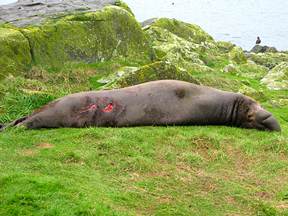 It turns out that the same behaviour was repeated in March of 2010 and Misery again sustained some more serious wounds.
It turns out that the same behaviour was repeated in March of 2010 and Misery again sustained some more serious wounds.
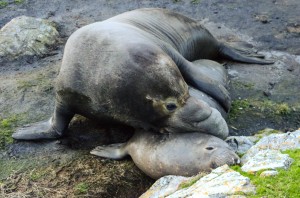 In February 2013, Bertha returned to the island but did not have a pup, the first time in four years. Misery however was there to mate with her, This post by Alex ipresents the images!
In February 2013, Bertha returned to the island but did not have a pup, the first time in four years. Misery however was there to mate with her, This post by Alex ipresents the images!
January 2014: we were expecting Misery back to harass the female elephant seals again as we come into breeding season. However, we have not seen Misery since he was seen sparring with Chunk back earlier in July 2013. His role has now been taken over by Chunk.
See all the postings on Misery in the Race Rocks log
Snow as an Abiotic factor at Race Rocks
| Every few decades, Victoria receives very large snowfalls, including the more than 100 cm (39 in) of snow that fell in December 1996. On the other hand, roughly one third of winters will see virtually no snow, with less than 5 cm (2 in) falling during the entire season. When snow does fall, it rarely lasts long on the ground. For Victoria Harbour, the climate records report annual mean snowfall totalling 29.3 cm ( about a foot) falling on 8 days..The Environment Canada website lists Victoria ( Airport ) as the city having the fewest snow days of all cities in Canada (10) The mildest winter (7.4 degrees average) and the lowest snowfall (43.8 cm.)The headlines in the Victoria Times for November 27, 2006 read :
“Snow shutdown |
| The snowstorm of November 26, 2006 can be traced from the Victoria harbour data on the Environment Canada website. Here it can be seen that the snow started on the morning of November 26 and continued until early morning of the next day. It snowed again midday on the 29th of November . The temperature that week took an unseasonal plunge. |
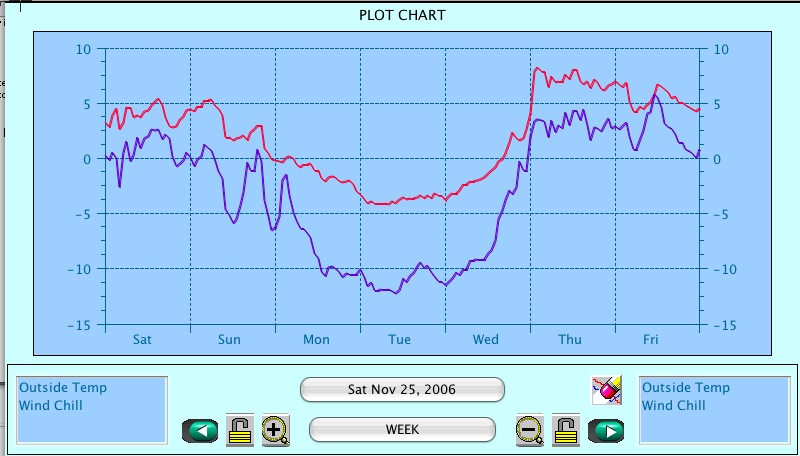
On Race Rocks our weather station recorded the windchill from the North East pushing the temperature down to minus 13 degrees Celsius
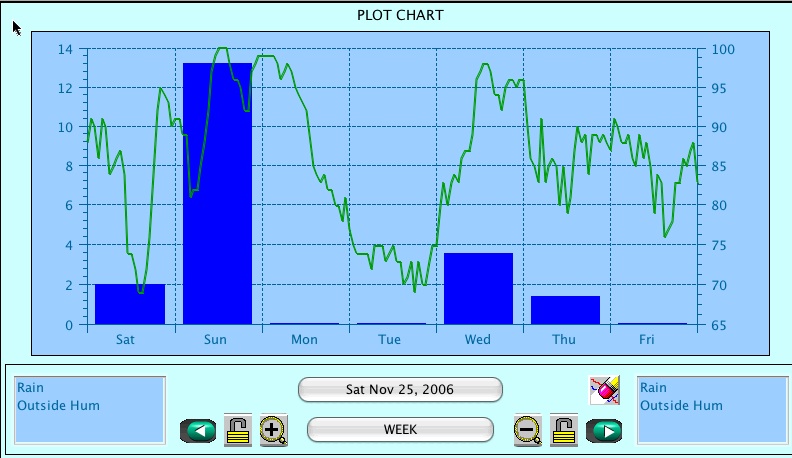
The blue bar represents rainfall, with the scale in mm.on the left. The green line is humidity. After Sunday, the freezing temperature prevented the instrument from registering rain. for several days. Due to blowing snow, it is unlikely that all snow that fell was measured..
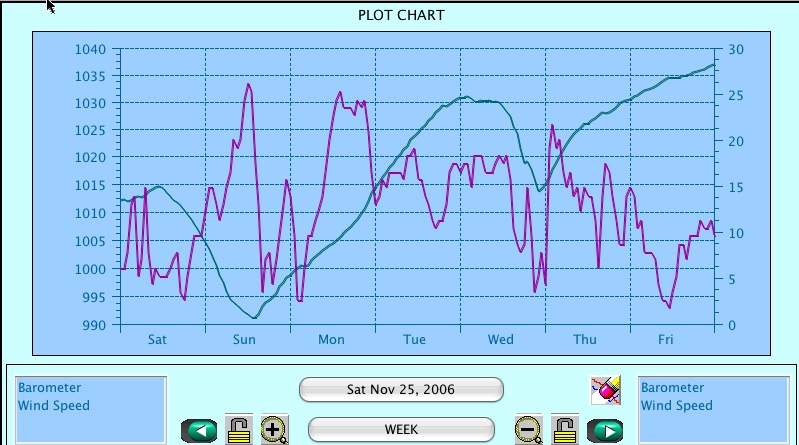
Wind speed is the purple line, and barometer is the blue line. Note how the barometer plunged just as the snowstorm started. The wind remained high for most of the week. This graph represents the surface wind profile. At the top of the tower it averaged 10-15 knots higher.
THE ABIOTIC EFFECTS OF SNOW:
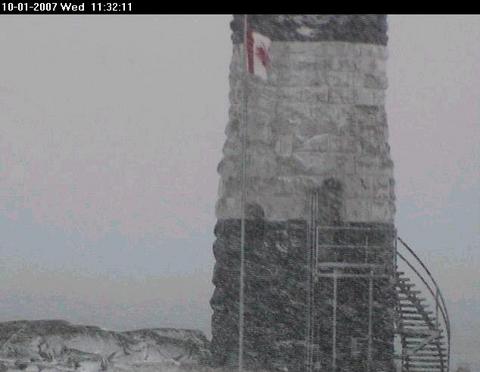 Our second snowfall for the year arrived on January 10, 2007. Pam Birley took this photo for us. This was unusual for Victoria as we had been smugly assuming that we had already had our share of snow that stayed for a week for the winter.
Our second snowfall for the year arrived on January 10, 2007. Pam Birley took this photo for us. This was unusual for Victoria as we had been smugly assuming that we had already had our share of snow that stayed for a week for the winter.
No research has been done at Race Rocks on the effects of snow on the animal and plant life other than the observation that the birds disappeared while these severe storm events were in progress. It is also almost impossible to access Race Rocks during a snowstorm since the wind blows in from the north-east and the exposure at the jetty prevents a boat from landing.
| See the exercise on the water cycle |
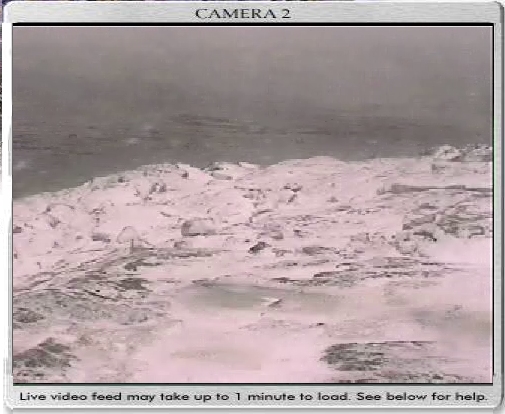 This image from the webcam in the November, 2006 snow storm showed a bleak landscape, with no seagulls in the usual spot. In a week they had all returned however, as mild temperatures returned.
This image from the webcam in the November, 2006 snow storm showed a bleak landscape, with no seagulls in the usual spot. In a week they had all returned however, as mild temperatures returned.
The topic of SNOW ECOLOGY has not been extensively studied. One of the classic works on the topic was done by William Pruitt of the Department of Biology at the University of Manitoba.
This paper is available from the TAIGA BIOLOGICAL STATION THESES AND RESEARCH PAPERS
( Formozov-inspired Concepts in Snow Ecology in North America. Bulletin Moscow Society of Naturalists, vol.104, No.3:pp.13-22. William 0. Pruitt, Jr.)
Records of snowfall from 1985 to February 1996 may be found on the Environment Canada Website Search that website for total snowfalls during that period click on British Columbia/advanced search/ then enter Race Rocks in the Search by Station Name section. Use the pull down menues to find the year, month or day of interest
Dermasterias imbricata: Leather star–The Race Rocks Taxonomy
- In a relaxed individual, the gills appear as a fuzzy covering.
- In the this view from underwater, the leather star does not have the gills deployed so it looks smooth
- The dorsal view of Dermasterias
- Ventral side of the Leather Star
- April, 2007, Kohei and Natan found this unusual 4-legged leather star
- In April, 2007, Kohei and Natan found this unusual 4-legged leather star.
Domain Eukarya
Usually when we find leather stars at Race Rocks, a search in the grooves underneath will reveal a symbiont, the scaleworm Arctonoe vittata. The worm also associates with various other marine invertebrates, but if separated from its host, will search out another member of the same species. The main predator of this sea star is the morning sun star
Kingdom Animalia
Phylum Echinodermata
Class Asteroidea
Order Valvatida
Family ASteropseidae
Genus Dermasterias
Species imbricata. (Dermasterias imbricata )(Grube, 1857)
Common Name: Leather Star
Garry Fletcher
Extreme Weather Events at Race Rocks
How We Got Blasted: Record-ripping winds took rare path:
Judith Lavoie, Times Colonist Published: Saturday, December 16, 2006
Wind gusts at Race Rocks, off the Island’s southwest tip, reached a record 158 kilometres an hour as the third intense wind storm in a week plowed a trail of destruction through southern Vancouver Island and the Lower Mainland. Yesterday morning’s storm knocked out power to thousands of residents, toppled trees, and damaged buildings and cars. More residents were forced from their homes because they didn’t have power, and ended up moving into hotels or into the homes of friends and relatives. Around the capital region, areas that suffered the most damage had winds that gusted to between 70 and 90 km/h . In the last three storms, including yesterday’s, the wind has gathered over the North Pacific, whooshed across the ocean, gathered speed in the funnel of Juan de Fuca Strait and then whacked Vancouver Island with its full force, said Chris Emond, Environment Canada meteorologist. “There are tremendous wind speeds and three in one week is unusual.” The wind is coming straight across the cold North Pacific and hitting land, rather than taking the more common route of dipping south and picking up tropical moisture, Emond said.
Anne McCarthy, weather services specialist with Environment Canada, said the storms are cutting a swath straight across Vancouver Island instead of the more usual pattern of tracking to the north coast around Prince Rupert and the Queen Charlottes (Haida Gwaii.) Although we have only recorded extreme values since earlier this year, It is interesting to note the Maximum wind and the Minimum Pressure records for the 14th and 15th of December 2006.
You can read the complete story in the Times Colonist , Dec 16, 2006 The right conditions for a hurricane: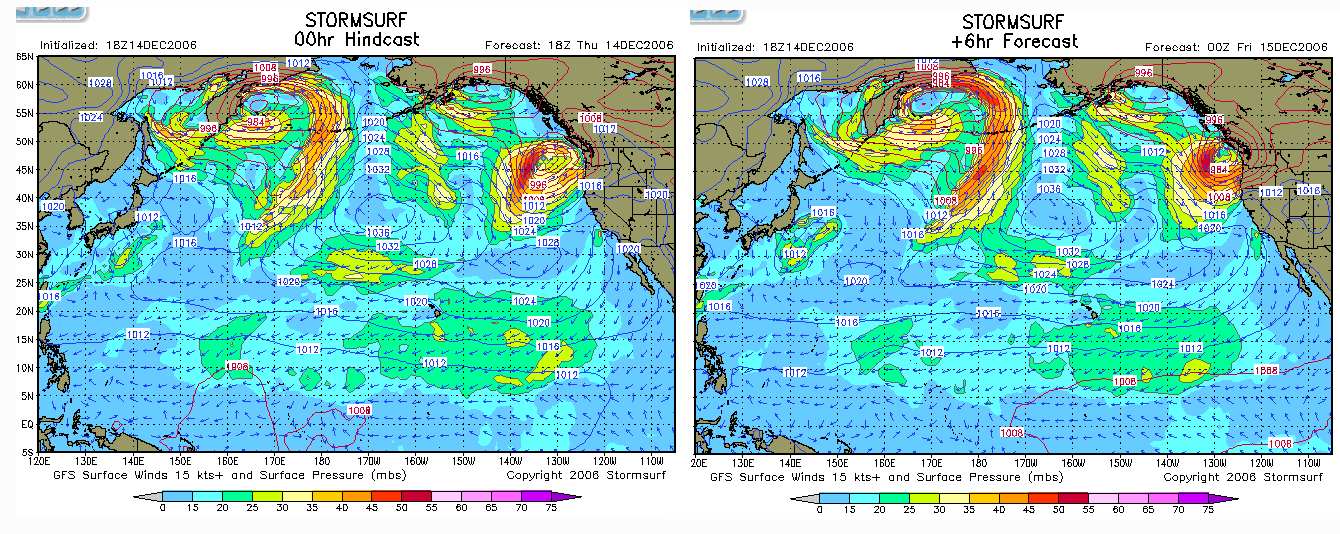
Storm surf conditions which correspond to the low pressure systems. These images were captured from the Stormsurf site at 2300 hrs. Pacific Time , just a few hours before the maximum impact.
This image was taken from the US National Weather Service Images of the evening of December 14. Note the “HURRICN FORCE” location right beside Vancouver Island. Also the atmospheric pressure is as low as 970.
Current Satellite imagery is shown on this page
- Maximum wind speed, averaged every 10 minutes..
- The barometer plunged to an extreme low of 960 Millibars
- High wind speeds are recorded here.. this is at ground level.. At the top of the tower it peaked at 158km/hr.
- The wind direction changed abruptly near midnight of the 14th as the advancing low pressure centre hurled toward Race Rocks from the West.
- The evidence was left on the lawn, well back from the waters edge.
- A newly placed water linehad the sod torn off, here it was replaced following the storm
- This area had boulders the size of buckets hurled up from the intertidal by the surging waves
- In the centre of the island, lashing water erroded a rock wall built many years ago
- First Nations burial cairns had rocks tumbled from their edges, and erosion of the soil from the centre of the cairn
- These cairns were built over a 1000 years ago, and have withstood many storms during that time. Here is a page documenting the Cairns.
- The forecast from Env.Canada at 4:00PM Thursday did not mention hurricane force winds
- This boulder was moved several metres. See file for the changes to the artificial tidepool from the hurricane of 2006
Doris montereyensis : The Race Rocks Taxonomy
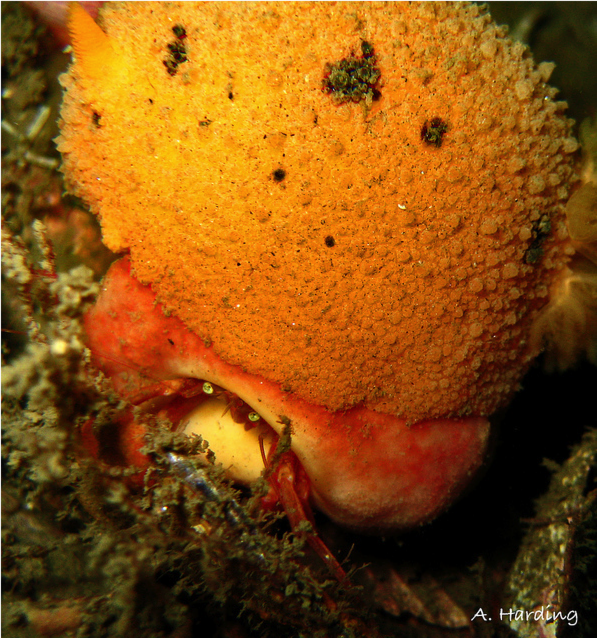
This rather unique image of a sea slug eating a suberites sponge which houses a hermit crab was take by Adam Harding , Sept, 2010
- Doris monteryensis
- Doris monteryensis Doris compared with the Noble Sea Lemon Peltodoris nobilis
- Doris monteryensis Doris compared with the Noble Sea Lemon Peltodoris nobilis


